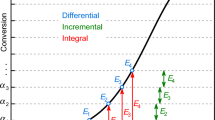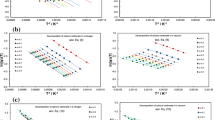Abstract
Arrhenius equation is popularly used to relate the change in the rate constant with temperature. The linearized form of Arrhenius equation has often been used to establish a relation between InA andE for a series of related reactions. Occurrence of such a compensating behavior between InA andE has been widely reported in the literature. The validity of the compensation effect has been heatedly debated. Compensation effect can arise from computational artifact or can arise from various chemical factors. This depends entirely on the data set used to establish the compensation behavior. This article stresses the importance of statistical analysis and the use of simple Arrhenius plots to draw conclusions regarding the occurrence of compensation effect. With the help of a few examples, some checkpoints to draw conclusions regarding the occurrence of true or false compensation effect are suggested.
Zusammenfassung
Die Arrhenius-Gleichung wird gewöhnlich zur Beschreibung des Zusammenhanges zwischen Geschwindigkeitskonstante und Temperatur benutzt. Die linearisierte Form der Arrhenius-Gleichung wurde dazu benutzt, eine Beziehung zwischen InA undE für eine Reihe von Reaktionen des gleichen Typs aufzustellen. Ein solches Kompensationsverhalten von InA undE wurde in der Literatur beschrieben, die Realität des Kompensationseffektes war jedoch Gegenstand heftiger Debatten. Ein Kompensationseffekt kann durch ein Rechenartefakt vorgetäuscht oder aber durch verschiedene chemische Faktoren bedingt sein. Dies hängt ausschließlich von der für den Nachweis des Kompensationsverhaltens aufgestellten Datenfolge ab. Dieser Artikel unterstreicht die Wichtigkeit der statistischen Analyse und die Verwendung einfacher Arrheniusgeraden für sich auf das Vorliegen eines Kompensationseffektes beziehende Schlußfolgerungen. An Hand einiger Beispiele werden einige Kontrollmöglichkeiten zur Unterscheidung tatsächlicher und vorgetäuschter Kompensationseffekte aufgezeigt.
Резюме
Уравнения Аррениуса широко используется для связи изменения конс танты скорости реакции с температур ой. Линейная форма ура внения была использована для опр еделения связи между InА иЕ в ряду род ственных реакций. Слу чай такого компенсацион ного влияния междуIn А иЕ был приведен в л итературе. Справедли вость этого компенсационн ого эффекта горячо обсуждалась. Компенс ационный эффект може т возникать как вследствии ошибо к вычислений, так и различных химич еских факторов. Это вс ецели зависит от набора дан ных, используемых при установлении ком пенсационного повед ения. В статье делается удар ение на важность статистического ана лиза и использования простых аррениусовских граф иков, чтобы сделать заключения, касающих ся случая компенсаци онного эффекта. На нескольки х примерах показаны некоторые проверочн ые точки для определе ния случаев истинного или фальши вого компенсационного эф фекта.
Similar content being viewed by others
Abbreviations
- A :
-
frequency factor or preexponential factor
- E :
-
activation energy or apparent activation energy
- k :
-
rate constant
- R :
-
gas constant
- T :
-
absolute temperature
- σ :
-
standard deviation Subscript
- iso :
-
isokinetic
References
F. H. Constable, Proc. Roy. Soc. London, Ser. A108 (1923) 355.
G. C. Bond, “Catalysis by Metals,” Academic Press, NY, 1962.
A. K. Galwey, Adv. Catalysis, 26 (1977) 247.
E. Cremer, Adv. Catalysis, 7 (1955) 75.
J. Zsakó and H. E. Arz, J. Thermal Anal., 6 (1974) 651.
Z. Adonyi and G. Körösi, Thermochim. Acta, 60 (1983) 23.
P. K. Gallagher and D. W. Johnson, Jr., Thermochimica Acta, 14 (1976) 255.
G. W. Collett and B. Rand, Thermochimica Acta, 41 (1980) 153.
C. Fairbridge, R. A. Ross and P. Spooner, Wood Sci. Tech., 9 (1975) 257.
E. Chornet and C. Roy, Thermochimica Acta, 35 (1980) 389.
R. K. Agrawal, “Kinetics of Biomass and Coal Pyrolysis,” Ph.D. Thesis, Clarkson University, NY, 1984.
R. K. Agrawal and R. J. McCluskey, J. Appl. Poly Sci., 27 (1983) 367.
R. K. Agrawal, F. Gandhi and R. J. McCluskey, J. Anal. Appl. Pyrolysis, 6 (1984) 325.
M. J. Antal, Jr., Adv. in Solar Energy, 2 (1983) 61.
F. Shafizadeh, J. Anal. Appl. Pyrolysis, 3 (1982) 283.
O. P. Golova, Russian Chem. Rev., 44 (1975) 687.
F. J. Kilzer and A. Broido, Pyrodynamics, 2 (1965) 151.
J. E. Leffler, J. Org. Chem., 20 (1955) 1202.
K. J. Laidler, “Chemical Kinetics,” McGraw Hill, NY, 1965.
L. P. Hammett, “Physical Organic Chemistry,” MacGraw Hill, NY, 1970.
G. Kemeny and B. Rosenberg, J. Chem. Phys., 53 (1970) 3549.
R. A. Fairlough and C. N. Hinshelwood, J. Chem. Soc. (1937) 538.
W. Linert, A. B. Kurdjantsev and R. Schmid, Aust. J. Chem., 36 (1983) 1903.
Wm. Curtis Conner, Jr., J. Catalysis, 78 (1982) 238.
P. D. Garn, J. Thermal Anal., 7 (1975) 475.
P. D. Garn, J. Thermal Anal., 10 (1976) 99.
O. Exner, Nature, 227 (1970) 366.
O. Exner, Collect. Czech. Chem. Commun., 37 (1972) 1425.
B. E. C. Banks, V. Damjanovic and C. A. Vernon, Nature, 240 (1972) 147.
J. Sestak, Talanta, 13 (1966) 567.
J. Sestak, J. Thermal Anal., 16 (1979) 503.
A. Blazek, “Thermal Analysis,” Transi. Ed. by J. F. Tyson, Van Nostrand Reinhold Co., 1973.
M. Arnold, G. E. Veress, J. Paulik and F. Paulik, Analytica Chimica Acta, 124 (1981) 341.
M. Arnold, G. E. Veress, J. Paulik and F. Paulik, Thermochimica Acta, 52 (1982) 67.
M. Arnold, G. E. Veress, J. Paulik and F. Paulik, J. Thermal Anal., 17 (1979) 507.
O. Exner and V. Beranek, Collect. Czech. Chem. Commun., 38 (1973) 781.
W. Linert, R. W. Soukup and R. Schmid, Computers and Chem., 6 (1982) 47.
R. R. Krug, W. G. Hunter and R. A. Grieger, J. Phys. Chem., 80 (1976) 2335.
R. R. Krug, Ind. Eng. Chem. Fund., 19 (1980) 50.
E. Cremer and E. Kullich, Radex Rundschau, 4 (1950) 175.
M. R. Alvarez, M. J. Tello and E. H. Bocanegra, Thermochimica Acta, 43 (1981) 115.
Author information
Authors and Affiliations
Rights and permissions
About this article
Cite this article
Agrawal, R.K. On the compensation effect. Journal of Thermal Analysis 31, 73–86 (1986). https://doi.org/10.1007/BF01913888
Received:
Revised:
Issue Date:
DOI: https://doi.org/10.1007/BF01913888




